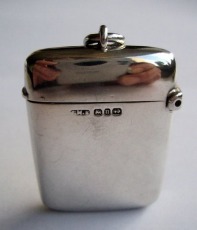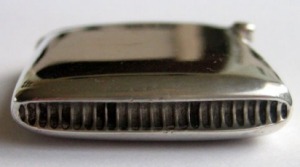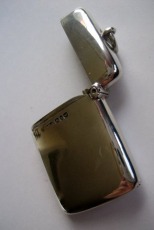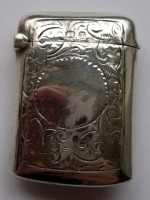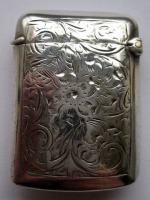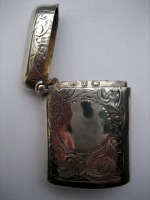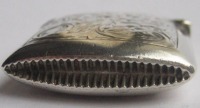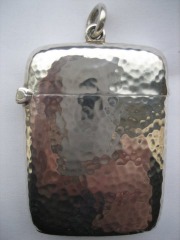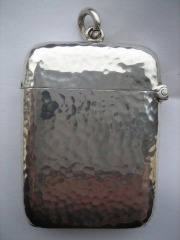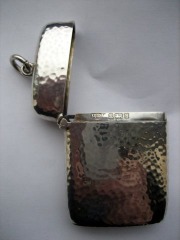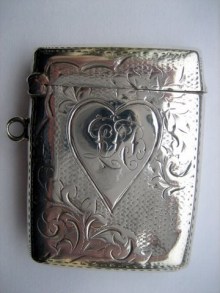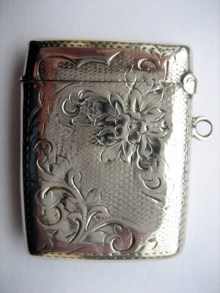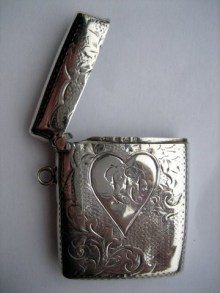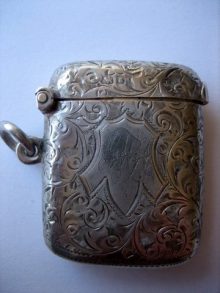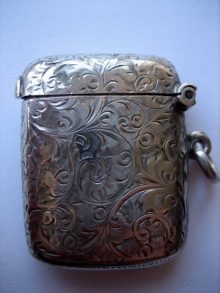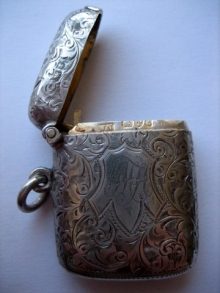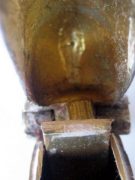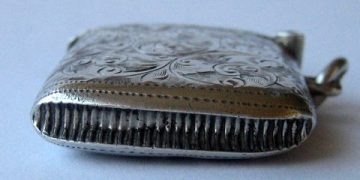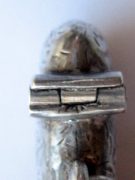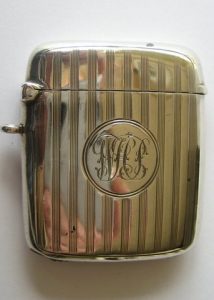by Robert
Massart
(click on photos to enlarge image)
DETERMINING THE PROFILE OF ENGLISH SILVER MAKERS
SILVER VESTA CASES BETWEEN 19TH AND 20TH CENTURY
It is quite self-evident that collectors of silverware try
to widen their knowledge related to the items obtained through
bargaining on markets, heritage, purchases on internet, etc. The
many requests of members to ASCAS asking for information
concerning silver items in their possession are a good example
of this obvious statement.
For English silver articles, the collector does not need to be a real expert.
Useful and comprehensive resources for the research are
pocket editions of English hallmarks
(note 1) or searching the
internet (note 2) to
identify the year the article was assayed, to learn the silver
content of it and to know in which town the item was assayed.
Tracing back the maker’s name linked to his mark (and eventually
information related to his career) needs more effort and is not
always apparent. It is therefore important to know that the
maker's mark in any hallmark is distinguished not only by the
initials but also by the style of the lettering and the shape
that surrounds them.
Studying a few English vesta cases hereafter illustrates that
research makes it possible to extend the volume of information
concerning the makers. Interesting to know is that some of the
maker’s marks for the period 1890-1920, may not be those of the
actual master silversmith but marks registered for the
manufacturing firm or wholesaler. Indeed, it was not uncommon
that Victorian silversmiths produced pieces with the maker’s
mark of the wholesaler. These marks where usually submitted by
the silversmith to the assay office for registration, on behalf
of the client. Actually, this is the reason why the assay offices
prefer to use the term sponsor’s mark instead of maker’s mark.
Before passing to the particular vesta cases discussed in
this article, some information regarding characteristics and
history of vesta cases in general may be of interest to the
reader.
Vesta cases came into use during the 1830s and due to the
exploding popularity of smoking they were produced extensively
between 1890 and 1920.
The small portable boxes were made to contain short matches and
keep them dry. The silver vesta cases were gilded inside to
avoid corrosion by the volatile match heads and the strike side
allowed lighting the match. Generally made to be carried in a
pocket, some were small enough to be suspended from an Albert
chain (named for Prince Albert, the husband of Queen Victoria)
to anchor it to a waistcoat. Further information about Vesta cases/Matchbox holders
are available in www.silvercollection
"Silver Dictionary"
BIRMINGHAM 1894
Small Victorian, perfectly shaped solid silver vesta case with a
typical hinged design. The chain ring is located on top of the
lid.
The hinged lid opens and closes with a clean snap. Clear crisp
set of hallmarks and maker’s mark on the front of the vesta case
and inside the lid. Fully gilt-lined interior to protect the
silver against corrosion.
The hallmarks are the lion passant for the sterling silver
standard guarantee, the gothic date letter ‘u’ for the year
1894-95 and the anchor for Birmingham (horizontal anchor for
pre-1900 silver).
The sponsor’s mark ‘J.M.B. in a rectangle with rounded corners’ (entered
at the Birmingham assay office May 1902) stands for John
Millward Banks who had premises at 6-7 Northhampton Street,
Birmingham and a shop in London. John Millward Banks,
established in 1863, died in 1911. The business was continued by
his son until c.1926.
The vesta case measures 43 mm by 32 mm, is 6,5 mm thick and
weighs 20 grams.
|
|
|
|
Front view
|
Striker underneath
|
Front view with open lid
|
|
|
|
Sponsor's mark and hallmarks on the front
|
Hallmarks inside lid
|
BIRMINGHAM 1897
Small Victorian, Arts & Crafts, solid silver vesta case (match
safe), finely engraved on both sides.
The front of the vesta case is engraved with scrolls and has a
vacant round cartouche, whereas the back side is adorned with
curves and a flower in the center. The hinge, spring and lid
work and fit very well.
No fob ring is present and considering the small size of the vesta it was certainly made
for a lady who could put it in a
purse. The striker on the base is in perfect condition. The
vesta case measures 40 mm high, 29 mm wide and 10 mm across.
Weight is 16 grams.
The clear struck hallmarks on the inner edge of the vesta and at
the outside of the lid are an anchor for Birmingham assay office
(horizontal for pre-1900 silver), the lion passant for sterling
silver and a gothic date letter ‘x’ for the year 1897-1898.
The inner edge of the case is also punched with the figure 2 (probably
the journeyman’s mark).
The sponsor’s mark is punched on the inner edge in such a way
that only the shape (a shield) and a letter H are visible. A
final identification is in this case not that easy; either it is
the mark of Edward John Haseler & Noble Haseler
(note 3) (entered August
1888) or, even more certain, of Thomas Hayes
(note 4) (entered December
1897).
|
|
|
|
|
Front view
|
Back view
|
Front view with open lid
|
strike underneath
|
|
|
|
|
Sponsor's mark and hallmarks on inside edge
of the vesta
|
Hallmarks on front of the lid
|
Figure "2" on rim of lid
|
BIRMINGHAM 1901
Victorian solid silver vesta case, embossed all around, with the
chain ring located on top of the lid.
The vesta case is gilded inside and the lid and spring are in
perfect condition. Measurements are 55 mm by 42 mm by 12 mm. The
weight is a good 38 grams. The bottom is marked on one side of
the missing striker with ‘Patent’ and at the other side with ‘Sirus’.
The hallmarks and sponsor’s mark are clearly struck on the
inside edge of the body and inside the lid.
Hallmarks are the anchor for Birmingham assay office, lion
passant for sterling silver and date letter ‘b’ for the year
1901. The sponsor’s mark ‘H & A in a rectangle with rounded
corners’ stands for Horton & Allday, who operated from their
Warstone Lane workshops, Birmingham from 1891 till 1933.
|
|
|
|
|
Front view
|
Back view
|
Front view with open lid
|
strike on the bottom
|
|
|
|
Maker's mark and hallmarks on inside edge of
the case
|
Hallmarks inside lid
|
BIRMINGHAM 1904
Typical Art Nouveau solid silver vesta case engraved all-over
with leaves and flowers. The lid is still tight fitting and the
striker is in good condition. A chain ring is present to the
side. The front is embellished with a heart shaped cartouche
that has been engraved with the initials LJB of the previous
owner.
The vesta case measures 48 mm by 36 mm by 9 mm. The weight is 20
grams.
Clear hallmarks are struck on the inner edge of the case and
inside the lid.
The hallmarks read as follows, anchor for the assay office of
Birmingham, lion passant for sterling silver and date letter ‘e’
for the year 1904.
The sponsor’s mark ‘T.H in an oval’ belonged to Thomas Heasley,
first registered in 1899. He registered as a whip maker and his
address was 138, Suffolk Street Birmingham.
|
|
|
|
Front view
|
Back view
|
Front view with open lid
|
|
|
|
Sponsor's mark and hallmarks on inside edge
of the case
|
Hallmarks inside lid
|
CHESTER 1905
Edwardian Art Nouveau solid silver vesta case with clear and
crisp hallmarks for Chester on the inside edge of the case.
The interior is gilded. It is engraved throughout with a scroll
and acanthus leaf design, typical for the Art Nouveau style. It
has a fine shield cartouche on the front, engraved with fancy
initials. The chain fob is located to the side of the vesta case
and the striker underneath is in perfect condition.
The vesta case is hallmarked for Chester
(note 5) with a shield
bearing the city arms (sword erect between 3 wheat sheaves),
lion passant for the sterling standard guarantee and the letter
‘E’ for the year 1905.
The sponsor’s mark ‘W.N in a rectangle with cut corners’ stands
for William Neale. His mark was entered in the Birmingham assay
office on April 1862 and in the Chester assay office on
September 1882. William Neale’s business was located on Warstone
Lane, Birmingham and subsequently on Cox Street, St Paul’s,
Birmingham.
The vesta case is 40 mm high, 31,5 mm wide and 10 mm across and
weighs 17 grams.
|
|
|
|
Front view
|
Back view
|
Front view with open lid
|
|
|
|
|
Detail of spring mechanism
|
Strike underneath
|
Detail of hinge
|
|
|
Maker's mark and hallmarks on edge inside
case
|
BIRMINGHAM 1913
Original "George V" solid silver vesta case (match holder and
striker) with banded decoration engraved throughout and with a
round cartouche on the front engraved with the previous owners
initials JHC.
It measures 50 mm by 43 mm by 9 mm and weighs 27 grams.
The interior is gilded, a chain fob is present to the side, the
striker on the base is in perfect condition and it has a snappy
tight lid.
The vesta case is clearly and fully hallmarked on the inner edge
of the case and there is a further matching set of silver
hallmarks inside the lid.
The hallmarks are anchor for Birmingham, lion passant for solid
sterling silver and date letter ‘O’ for the year 1913. The
sponsor’s mark, ‘WHH in a rectangle with cut corners’, stands
for William Hair Haseler.
The firm of goldsmiths, silversmiths and jewellers was founded
in 1870 by William Hair Haseler and went in formal partnership
with Arthur Lasenby Liberty
(note 6), founder of Liberty & Co, whose particular
importance was his role in relation to the Aesthetic Movement
(note 7) and Art Nouveau
(note 8), often known in
Italy as Stile Liberty. The two firms joined forces from 1898 on
to launch the Cymric silver range under the name Liberty & Co (Cymric)
Ltd.
The machine produced silver and jewellery was hand finished and
often decorated with a variety of semi precious stones, giving
it a luxury look.
Celtic motifs were a real source of inspiration for designers
such as Archibald Knox (note 9),
who worked for Liberty & Co.
Knox remained anonymous because Liberty adopted the policy of
not promoting the names of the designers he used, in order to
keep the public’s full attention to his own brand identity.
William Hair Haseler continued to produce silver for Liberty &
Co until the partnership of both firms ended in 1926.
|
|
|
Sponsor's mark and hallmarks on inside edge
of the case
|
Hallmarks inside lid
|
ENDNOTES
1 Inexpensive pocket books are for instance Bradbury’s Book of
Hallmarks (ISBN 0 901100 32 3) and Pocket Edition Jackson’s
Hallmarks (ISBN 1 85149 169 4).
2 Identification of Birmingham hallmarks and Sponsor's marks
from 1773 till 1858, the Birmingham Assay Office has launched a
new, Early Silver Hallmarks website. Any silver collector who
may have acquired, for example an early Birmingham silver snuff
box with a maker’s mark they don’t recognise, or perhaps a
recent beneficiary of a will who has inherited a set of
nineteenth-century Birmingham silver salts and would like to
know who made them will find this website of immense value. You
can visit the website at
www.theassayoffice.co.uk.
Another valuable source, of course, can be found at
www.silvercollection.it , a site created by Giorgio Busetto.
3 Also known as Haseler Brothers, Branston Street workshops,
Birmingham
4 T. Hayes had his workshops at Hockley Street, Birmingham. He
became bankrupt in 1907. In 1910 he was found mutilated on a
railway line and after being charged with attempted suicide he
died of his injuries in the police station.
5 The Chester Assay Office closed 24th August 1962.
6 Arthur Lasenby Liberty started a small shop in 1875 on the
corner of Regent Street, London, selling imported exotic goods
from the East. Soon he became well known in fashionable
retailing. His success was due to the fact that he succeeded in
promoting design to the broad public by reducing the high
production costs, which were typical for handcrafted pieces made
by the Arts & Crafts movement.
Liberty received a knighthood in 1913 in recognition of the
significant role he had played in promoting the decorative arts
in Britain. He died in 1917.
7 The Aesthetic Movement existed in Britain during the 1870’s
and 1880’s and manifested itself in the fine and decorative arts
and architecture. It was characterized by the cult of the
beautiful and the emphasis on the sheer pleasure to be derived
from it.
8 Art Nouveau is the name for the artistic trend in decoration
and architecture during the period between 1880 and 1914, as a
reaction on the fading norms of impressionism. Characterized
particularly by the depiction of leaves and flowers in flowing,
ornamental lines. The same style-characteristics exist for
buildings, furniture and ornamental objects.
9 Archibald Knox, born 9 April 1864 in Cronkbourne Village, Isle
of Man - died 22 February 1933, Isle of Man. He was a famous
English designer, silversmith and painter. His flair and
artistry was the reason of the success of the Cymric silverware.
The collaboration of Knox and Liberty ended in 1912.
|
|
 ASSOCIATION OF SMALL COLLECTORS OF ANTIQUE SILVER
ASSOCIATION OF SMALL COLLECTORS OF ANTIQUE SILVER